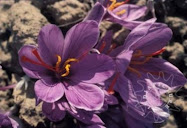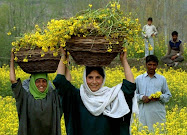The control or regulation of breath (Prana) is called Pranayama. All the functions of the body are directly or indirectly related to Prana. Pranayama on one hand has the capacity of freeing the mind of untruthfulness, ignorance and other painful and unpleasant experiences of the body and mind and on the other helping in the meditative process to arouse the Kundalini Sakhti and bring it up to the crown of head. It is a systematic exercise of respiration which makes the lungs stronger, improves blood circulation and enables a man to lead a healthy and long life. Lalla is essentially a great advocate of the practice of Yoga particularly Pranayama for achieving perfection in meditative process. She stresses upon the seeker to dedicate on Pranayama and beautifully compares the process with the working of a goldsmith who diligently directs the air current into his fire-place to heat up the material to separate the impurities out of gold. Lalla advises the seeker in the divine path to systematically practice breath exercise so that the gold of his devotion is sorted out exclusively pure to achieve the desired goal.
Soen thav thaji tay hosh thav phokas, Lolaki nare sorus vaichar
Soey ras sartali vavath pyayee, Ade soen sapdye kundan kaar.
Sincere devotion and extreme love of the Lord serves as catalyst in the process of the achievement of all spiritual goals just as a goldsmith succeeds in getting the purest form of gold without hurdles with the process of catalysis. The practice of breath (Pranayama) is the choicest exercise in Yoga which has the capacity to give an instant lift to the seeker.
Dwadash mandlas yas deevas thaji, Naasik pavan daari anahat rav
Swayam kalpane antah chaji, Suy deev tay archun kas.
Lalla says, ‘One who has got the perfection in Yoga, i.e. the supreme realization of self through deep devotion and practice of Pranayama, is the highest achiever in Yoga. He is also the one who has succeeded in awakening the supreme power of Kundalini Shakti to the crown of his head through the practice of the subtle flow of Prana through his nostrils. This is the supreme spiritual achievement where the distinction between the Lord and the seeker vanishes, and there remains none else for the devotee to worship except his own self.’
Dama-dam kormas daman halay, Prazleom deep te nanyayam zaat
Andraem prakash neabar chotum, Gati rotum te kaermas thaph.
Lalla says, ‘I continued with the inhalation and exhalation of breath (Pranayama) uninterruptedly till my inner consciousness began to glow brightly and I recognized my real self. My inner realization began showing its impact outside and my whole being changed with a celestial glow on my face. I caught hold of my changed self firmly with further meditation and didn’t let it go till I held incessantly a clear view of my Lord before me.’
Daman bastay ditto dil, Damnas yithe damaan khaar
Shaestras soen gaechey haesil, Wune chaiy sul te chandun yaar.
Lalla calls upon the seeker to devote himself deeply to the practice of Pranayama as a goldsmith who works on his instrument which throws a current of air continuously on to the burning coal in his fireplace to separate pure gold from the dross. Similarly the continuous practice of exhalation and inhalation of breath will help the seeker concentrate on his inner self to liberate it from the bondages of the worldly attractions and get nearer to the Lord. All worldly glamour is compared to the black iron which can be transformed into pure gold of divine awakening with uninterrupted practice of Yoga.
Pranas saety lai yali karem, Dyanas thavnam ne roznas shaai
Kayas andar soruy vuchum, Payas povum te kaedmas graai
Lalla describes her own experience of Pranayama when she became an adept in the process; she lost all her consciousness of self and experienced all the contours of the cosmos in her own self. She got clear awakening of all the divine secrets and there remained nothing unrealized for her. Here Lalla indicates to her ultimate divine realization through the practice of Pranayama and the subsequent awakening of Kundalini Sakhti to its highest stage which opens all the doors of awakening for the seeker.
Pawan te praan somuy dyuthum, Meelith roodum sheri khor taaen
Dhih yali mothum adhe kyah motum, Na kuni pavan tay na kuni praan.
On achieving higher concentration in meditation the seeker does not find any difference between the normal respiration and the practice of Pranayama as his normal respiration becomes such a controlled process that the body does not require the normal breathing as with the impact of the meditative process almost all the normal functions of the body cease to be and the whole system is controlled by a higher regulation. ...... (to be continued)
Subscribe to:
Post Comments (Atom)
.jpg)




Thank you for this beautiful outline on Lalla's Philosophy vis a vis Pranayama.The above illustration is similar to meditation used for awakening the Kundalini Shakti in Sahaja Yoga.
ReplyDelete